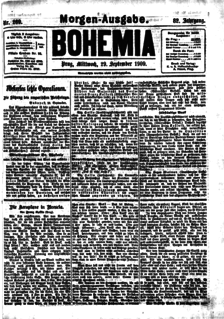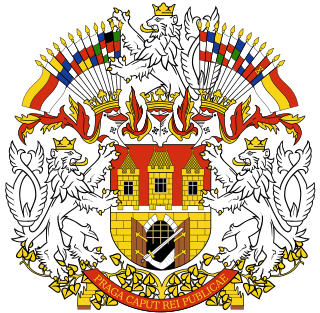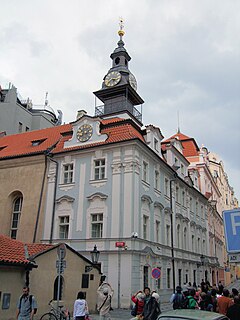 W
WThe history of Prague covers more than a thousand years, during which time the city grew from the Vyšehrad Castle to the capital of a modern European state, the Czech Republic.
 W
WOperation Anthropoid was the code name for the assassination during World War II of Schutzstaffel (SS)-Obergruppenführer and General der Polizei Reinhard Heydrich, head of the Reichssicherheitshauptamt, the combined security services of Nazi Germany, and acting Reichsprotektor of the Protectorate of Bohemia and Moravia.
 W
WAnti-capitalist Protests in Prague took place during the International Monetary Fund (IMF) and World Bank summit in September 27, 2000 in Prague, capital of the Czech Republic.
 W
WThe Battle of White Mountain was an important battle in the early stages of the Thirty Years' War.
 W
WBohemia was a German newspaper published in Prague from 1828 to 1938.
 W
WThe coat of arms of the city of Prague, the capital of the Czech Republic, has a lesser and a greater version.
 W
WThe Decree of Kutná Hora or Decree of Kuttenberg was issued on 18 January 1409 in Kutná Hora (Kuttenberg), Bohemia by King Wenceslaus IV to give members of the Bohemian nation a decisive voice in the affairs of the Charles University in Prague.
 W
WDolní Počernice is an architectural monument located at 1 Národních hrdinů street in Dolní Počernice, near the dike Počernický fishpond and a local English park. It is protected as a cultural monument of Czech Republic. Currently an orphanage is located there. Next to the castle is a small church from the 12th century, which originally was built in Romanesque style.
 W
WIn Jewish folklore, a golem is an animated anthropomorphic being that is created entirely from inanimate matter. The word was used to mean an amorphous, unformed material in Psalms and medieval writing.
 W
WThe history of the Jews in Prague is one of Central Europe's oldest and most well-known. Prague boasts one of Europe's oldest recorded Jewish communities, first mentioned by an Mizrahi-Jewish traveller Ibrahim ibn Yaqub in 965. Since then, the community never ceased to exist, despite a number of pogroms and expulsions - and the holocaust and subsequent antisemitic persecution by the Communist regime in the 20th Century. Nowadays, the Jewish community of Prague numbers approximately 2,000 members, although the number of Jews in the city is probably as high as 10,000 but for various reasons they remain officially unregistered as such. There are a number of synagogues of all Jewish denominations, a Chabad centre, an old age home, a kindergarten, Lauder Schools, Judaic Studies department at the Charles University, kosher restaurants and even a kosher hotel. Famous Jews from Prague include the Maharal, Franz Kafka, Miloš Forman and Madeleine Albright.
 W
WKobylisy Shooting Range is a former military shooting range located in Kobylisy, a northern suburb of Prague, Czech Republic.
 W
WLangweil's Model of Prague is a realistic paper model of Prague dating from 1826–1837 and named after its creator Antonín Langweil. Due to Langweil's early death, the model remained unfinished. It covers an area of 20 m2 and shows more than 2,000 buildings in the historic heart of Prague in fine detail; approximately half of them do not exist anymore, largely due to an extensive urban sanitation project that included a planned demolition of large portions of the city's Old, New and Jewish towns between 1896 and 1943. The Langweil Model is thus the only existing depiction of the entire Prague Ghetto in its pre-1890s appearance. It is also a worldwide unique authentic witness of the appearance of a city in the first half of the 19th century.
 W
WThe Monument to Soviet Tank Crews was a World War II memorial located in Prague. It is also known as the Pink Tank because, in 1991, it was controversially painted pink, first by installation artist David Černý and a second time by members of parliament in protest at his arrest.
 W
WThe National Library of the Czech Republic is the central library of the Czech Republic. It is directed by the Ministry of Culture. The library's main building is located in the historical Clementinum building in the centre of Prague, where approximately half of its books are kept. The other half of the collection is stored in the district of Hostivař. The National Library is the biggest library in the Czech Republic, housing around 6 million documents. The library currently has around 20,000 registered readers. Although comprising mostly Czech texts, the library also stores older material from Turkey, Iran and India. The library also houses books for Charles University in Prague.
 W
WOld Town Square execution was the execution of 27 Bohemian leaders of the Bohemian Revolt by the Austrian House of Habsburg that took place on June 21, 1621 at the Old Town Square in Prague.
 W
WThe Prague City Archives is one of the departments of the Prague City Hall. It collects, preserves, processes and makes available archival materials documenting the historical development of Prague since the Middle Ages up to the present. Together with the National Archives of the Czech Republic the Prague City Archives is one of the largest and most important archives in Bohemia.
 W
WPrague City Hall is municipal and regional office of Prague the capital of Czech Republic. It is formed by the Chief Executive of Prague City Hall and other employees of the City of Prague included in this body. Prague City Hall performs tasks assigned by Prague City Assembly or Prague City Council, which are democratically elected. As of 2017, it employed 2,091 people and had a budget of 65,193 bilion CZK.
 W
WThe Prague Declaration on European Conscience and Communism was a declaration which was initiated by the Czech government and signed on 3 June 2008 by prominent European politicians, former political prisoners and historians, among them former Czech President Václav Havel and future German President Joachim Gauck, calling for "Europe-wide condemnation of, and education about, the crimes of communism." Much of the content of the declaration reproduced demands formulated by the European People's Party in 2004, and draws heavily on totalitarianism theory.
 W
WOn April 29, 2013 at around 10:00am CEST, an explosion occurred in a building in the centre of Prague, Czech Republic. The incident occurred in a townhouse belonging to the Air Navigation Services of the Czech Republic on Divadelní street in Old Town, Prague 1, close to the Academy of Sciences and National Theatre. The blast could be heard across the whole city centre, as far away as Prague Castle, 1.4 km (1 mi) away from the incident. 43 people were injured by the blast, one seriously. No one was killed. The resulting shock wave from the blast damaged windows in nearby buildings including the National Theatre, Café Slavia, the Film and TV School of the Academy of Performing Arts in Prague (FAMU), the Faculty of Social Sciences of Charles University and the Academy of Sciences of the Czech Republic.
 W
WThe Prague groschen was a groschen-type silver coin that was issued by Wenceslaus II of Bohemia since 1300 in the Kingdom of Bohemia and became very common throughout Medieval Central Europe.
 W
WThe Prague uprising of 1945 was a partially successful attempt by the Czech resistance to liberate the city of Prague from German occupation during World War II. The preceding six years of occupation had fuelled anti-German sentiment and the approach of the Soviet Red Army and the US Third Army offered a chance of success.
 W
WStalin's Monument was a 15.5 m (51 ft) granite statue honoring Joseph Stalin in Prague, Czechoslovakia. It was unveiled on 1 May 1955 after more than 5 1⁄2 years of work, and was the world's largest representation of Stalin. The sculpture was demolished in late 1962.
 W
WThe 2002 Prague summit was a NATO summit held at the Prague Congress Centre where the heads of state and government of the NATO member states met. Seven states were at this summit invited to begin accession talks with NATO: Bulgaria, Estonia, Latvia, Lithuania, Romania, Slovakia and Slovenia. NATO's post-Cold War Open Door Policy was also reaffirmed at this meeting. A NATO Response Force was considered and planned at this moment, a force which would be officially declared ready at the 2006 Riga summit.
 W
WThe Estates Revolt was the first anti-Habsburg uprising of the Czech estates, which took place in Prague in January - July 1547, and the third uprising of the estates in the Habsburg Empire after the Revolt of the Comuneros in Spain (1520-1522) and the Revolt of Ghent in Flanders (1539-1540). The uprising was triggered by the absolutist policies of King Ferdinand I of Habsburg, aimed at reducing the political influence of the privileged estates and the recatolization of the lands of the Bohemian Crown.
 W
WThe Vyšehrad Chapter, officially the Royal Collegiate Chapter of Ss. Peter and Paul at Vyšehrad, is a collegiate chapter established at the church dedicated to Saints Peter and Paul in Vyšehrad around 1070 by Vratislaus, the first king of Bohemia.